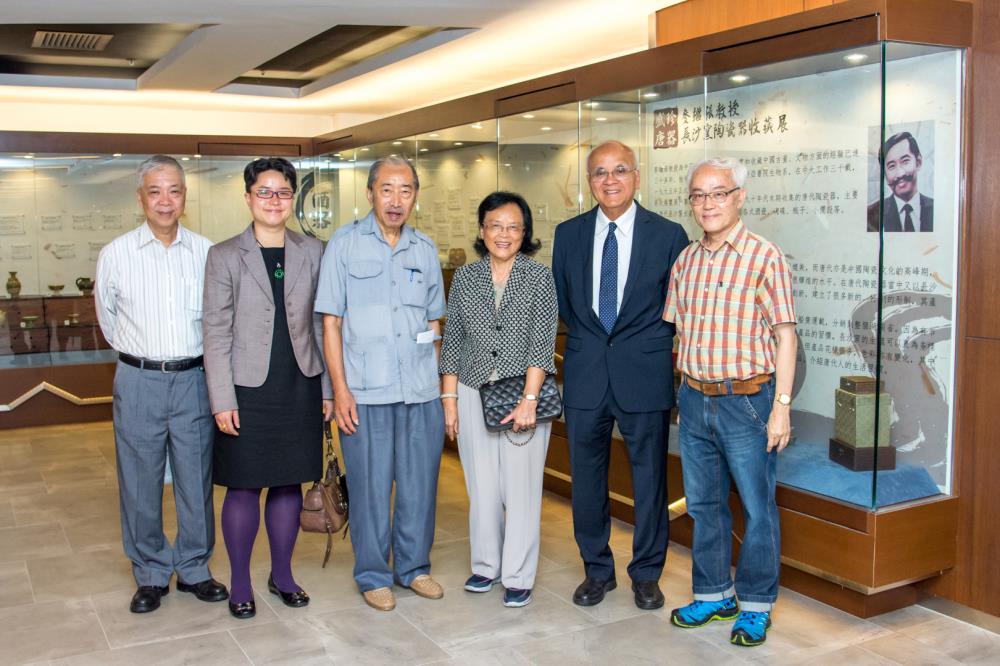A Glimpse of Tang Porcelain Culture

The College is presenting the exhibition ‘Treasures from Tang Dynasty—Prof. Kai Keung Mark’s Collection of Chinaware from Changsha Kiln’ until 3 October 2016. The exhibition showcases Prof. Kai Keung Mark’s collection of Tang dynasty chinaware, mainly from the Changsha Kiln, gathered during the early 1990s. It includes over 80 exhibits of various wine pots, bowls, plates, vases and bibelots.

The opening ceremony was held on 12 August. Officiating guests included Prof. Kai Keung Mark and his wife Mrs. Oi Wah Mark; Prof. Samuel Sun, Master of S.H. Ho College, CUHK; Prof. Xu Xiaodong, Associate Director of the Art Museum; and Miss Angela Ng, President of the Student Union Executive Council, S.H. Ho College.

Prof. Samuel Sun, Master of S.H. Ho College, said, ‘Through the exhibition of Changsha porcelain in the Tang dynasty, the College hopes to enhance students’ cultural and artistic knowledge. The College also wants to take this opportunity to celebrate Prof. Kai Keung Mark’s 80th birthday and to thank him for lending generously his collection of chinaware.’

Prof. Kai Keung Mark is a collector of Chinese cultural relics, with over 30 years’ experience in collecting and appreciating Chinese antiques. He taught at the Department of Biology, CUHK for 30 years up to his retirement in 1995. Many postgraduates were under Prof. Mark’s supervision during his service at CUHK, among them Prof. Lap-Chee Tsui, the former Vice-Chancellor and President of The University of Hong Kong who was Prof. Mark’s first Master’s student.
Prof. Mark said, ‘I chose Changsha porcelain in the Tang dynasty as the theme for this exhibition because the Changsha collection, with its diversified shapes and decorations, reflects comprehensively the design characteristics, superlative craftsmanship and innovative directions in Tang porcelain at large. We can also explore the gorgeous way of living at that time from this collection.’

Chinese culture and porcelain production rose to a new height in the Tang dynasty (618-907). Pottery manufacture was improved in nearly every aspect, making Tang porcelain available in a wide range of colours and shapes. The most important contributors to porcelain production at that time were Changsha potters who created glaze colours which the world first saw in porcelain. They energetically invented creative forms of functional ceramics, both for daily use and as art works for appreciation. The Tang potters achieved their greatest technical innovations and artistic refinements by inventing porcelain, underglaze painted décor and phosphatic glazes, perfecting high-fired celadon, and experimenting with cobalt blue glazes.

Situated at Xiangjiang port, Changsha used to be a porcelain production centre where products were transported by boat to other cities in Hunan province. Thanks to the huge market demand for porcelain in the wealthy Tang society in which people hankered after refined daily utensils, the Changsha potters created a splendid array of chinaware which is uniquely Changsha. Although the Changsha Kiln mainly manufactured celadon, its products displayed gorgeous variations in design and colour. Among its creations, wine pots and articles for daily use are the most famous. We can have a glimpse of the Tang way of living through the collection of utensils used at the time.

Prof. Mark said we could appreciate the uniqueness of these exhibits from several aspects. First, with regard to shape, wine pots from Changsha Kiln have a pentagonal but not a round liu (the mouth of a spout from which liquids are poured), which is distinctively Changsha. Second, the handles of Changsha utensils come in many different shapes and sizes, displaying a strong Tang ceramic style. Third, the Tang porcelain was often designed to recall metalware. For instance, the Changsha potters sometimes created a sharper angle at the joints where protruding parts or decorations were adhered to a ceramic surface to mimic metalware. Examples of this method can be found in Changsha wine pots, bowls and plates.